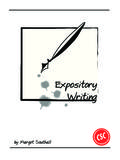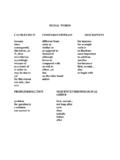Transcription of Lesson Skill: The writing process for expository writing
1 English Enhanced Scope and Sequence Lesson Skill: The writing process for expository writing Strand writing SOL , , , Materials Student writing portfolios Samples of good expository writing from the textbook, magazines, newspapers, or online sources Computer access for all students Copies of the attached expository writing Prompt worksheet Lesson Module 1 Prewriting 1. Give a brief Lesson on the meaning of the word expository . Write the word on the board and ask students to look for its root. When students recognize the word expose, build on that by explaining that to expose means to show, which is exactly what expository writing does it shows or explains how to do something.
2 Give some examples of expository writing to students, or ask them to share some examples that they have done in the past. 2. Distribute writing portfolios, and quickly review the students notes on the writing process . 3. Have students look at samples of good expository writing from the textbook, magazines, newspapers, or online sources. While they are looking over these writings, have students take particular notice of the items on which they have already taken notes in their writing portfolios, , effective hooks, topic sentences, paragraph structure/organization, elaboration, sentence variety, specific vocabulary, transitions, and other such elements.
3 Discuss these items as they are spotted in the sample writings. 4. Distribute copies of the attached expository writing Prompt worksheet, and have students read the prompt and underline the words they think are the key words. Take a few minutes to discuss the students chosen key words and their reasons for choosing them. 5. Have students brainstorm to narrow their topic. It is important that students understand that they must first choose or invent a place to visit and then develop solid reasons for their choice that can be easily explained in their paper.
4 Remind English Enhanced Scope and Sequence students that once their thoughts have been narrowed and organized on their graphic organizer (prewriting), they should continue to the drafting stage of the writing process without delay. Drafting 6. Have students complete the drafting stage of the writing process . Remind them to make use of the notes in their writing portfolio, looking back at their notes on, among other things, writing effective hooks and effective paragraphs. 7. Have students organize the completed parts of their expository writing and file them in their writing portfolios.
5 Module 2 Revision 8. Review the purpose of expository writing , and remind students of the importance of keeping that purpose in mind throughout the writing process . Tie purpose and audience for this writing back to the prompt. 9. Distribute student writing portfolios, and instruct students to take out the completed prewriting and draft versions of their expository writing . 10. Tell students that their writings should be revised, edited, and published by the end of today s class. Have students refer to writing process notes in the portfolios, if necessary.
6 11. Review the writing domain rubrics in the portfolios so that students will understand how their papers will be assessed. Review the revision and editor s checklists in the portfolios, reminding students that these are the guidelines they will use to check their papers. 12. Allow students time to revise and edit their papers, using their revision and editor s checklists. 13. Put students into pairs for peer editing, which is helpful not only because another pair of eyes will be examining the paper, but also because the author will understand whether or not the writing is clear to someone else.
7 Instruct the students to read their partners papers aloud but just loud enough so the author can hear it and to make any corrections he/she deems necessary, including circling any words that need to be listed on the author s Tired Terms chart. 14. Instruct students to add any circled words to their Tired Terms chart and to use a dictionary and/or thesaurus to find alternate words. Upon completion of this task, students should be ready to write their final draft. 15. Allow students the remainder of time to write the final, clean draft. 16.
8 Have students organize all parts of their expository writing for collection. 17. Have students complete an exit slip on which they list the tired terms that they removed from their paper. English Enhanced Scope and Sequence expository writing Prompt Prompt No. 951 You have the opportunity to visit anywhere you want. Explain where you would visit and the reasons you chose this place.















![[A Work in Progress] - Bible Professor](/cache/preview/e/e/3/3/2/d/c/f/thumb-ee332dcf388452f3fc2160af1dec50c3.jpg)

